How To Draw Snow Covered Pine Trees
How to Draw Trees
Updated: 24 Feb 2022

In this guide, I will demonstrate how I simplify the drawing process, and I hope that by the end of it you lot will be able to depict your favorite tree.
In social club to depict realistic trees with pen and ink, information technology is of import to pay attending to accuracy of the form (structure), and to learn how to create the illusion of effulgence values and transitions with pens.
Bamboo
When looking at ANY tree, examine its basic shapes.
It is a good practice to draw its simple shapes kickoff:
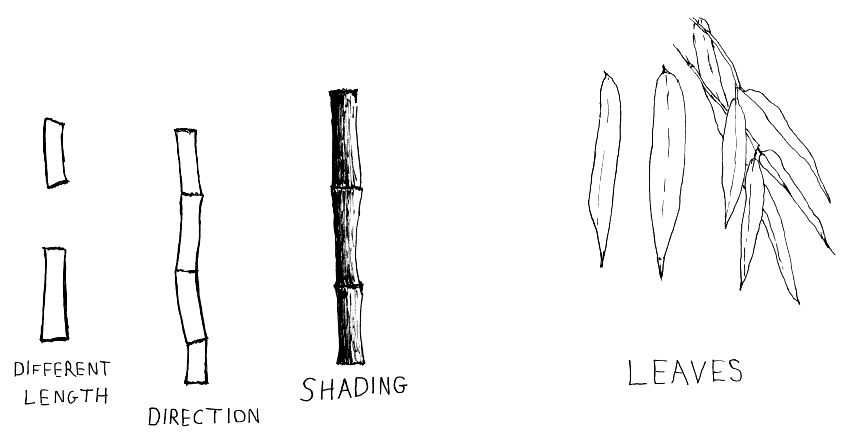
Once you lot understand these elementary shapes, you lot can use your artistic license and your cognition to recreate it.
In that location is no point drawing every single leaf as you meet it (when using a reference image as a guide).
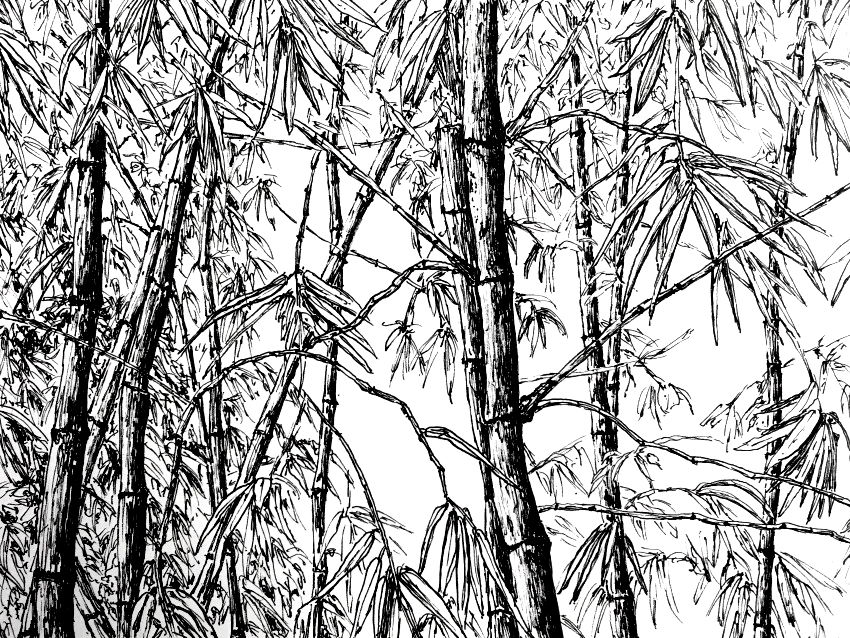 Bamboo
Bamboo
Banana Tree
For trees with large leaves, like a banana tree, commencement depict a study of the leaves from different angles.
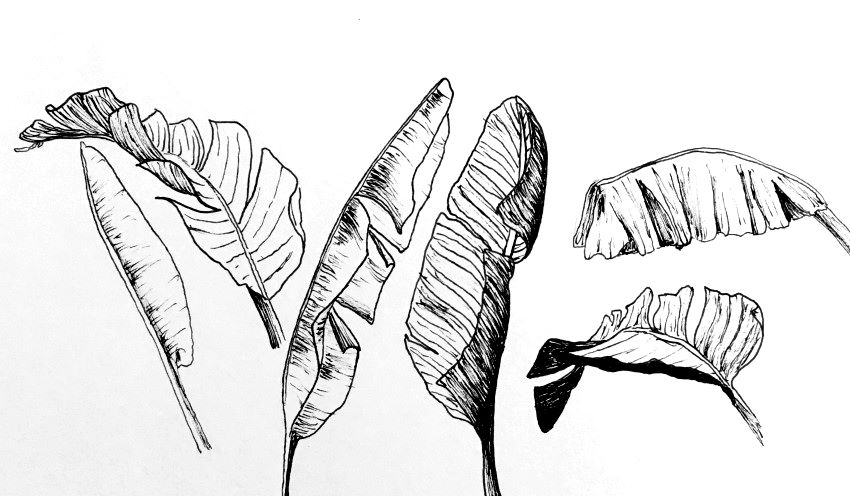
For a realistic outcome, make sure there is no symmetry, and that each foliage is unique.
You tin can use markers; they work well with pens.

Olive Tree Torso
Look at some reference images, or actual trees, before drawing the tree trunk.
First, draw outlines to create the form (structure).
Remember:
Draw thin and gentle outlines, so they are not assuming.
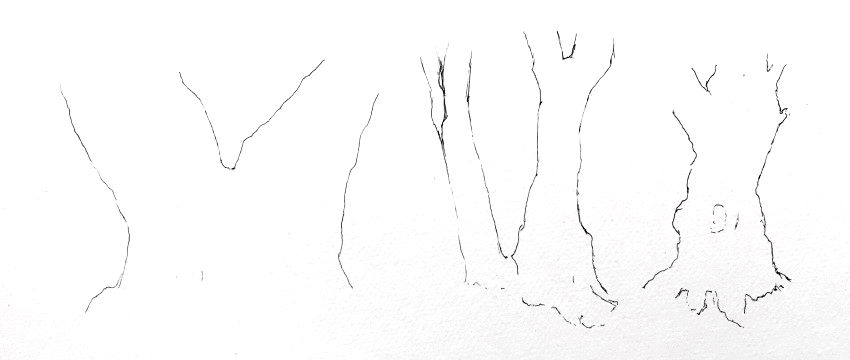
Adjacent, add some guidelines and basic details.
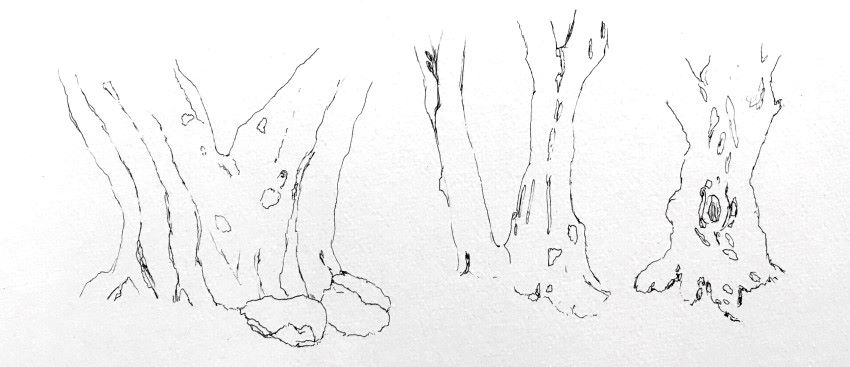
Last stride is texture cartoon.
Focus mainly on brightness values, while drawing marks with shape and direction like the reference image.
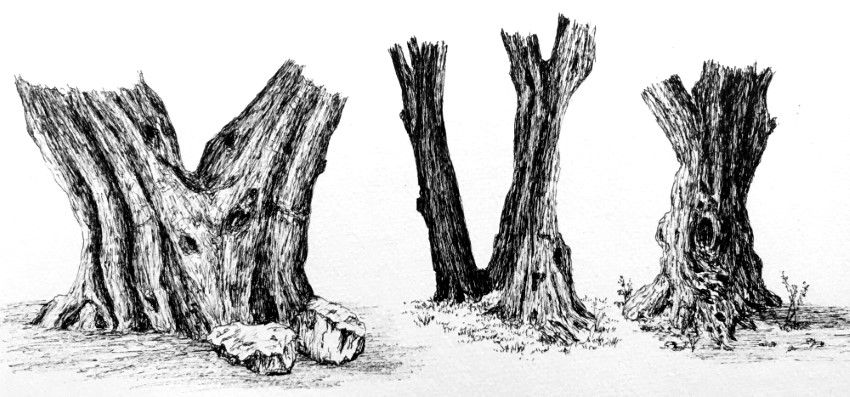 Olive tree trunks
Olive tree trunks
Keep in mind:
Each olive tree body has its ain "personality", simply all olive copse share mutual basic shapes.
How to Depict Leaves
Drawing leaves tin can be challenging. Agreement their structure, and breaking the cartoon procedure into steps, will produce a satisfying and realistic result.
Each tree leaf is in different direction, has a different degree of foreshortening, and is overlapping other leaves.
But put, the form and texture of leaves is abstract and messy.
To draw that, you lot demand to be sketchy and loose with your marks, and to avoid any pattern!

Next step is to pay attending to brightness values. That is how you create the illusion of volume. Pregnant, 3-dimensional and non apartment.
To create that illusion, scribble more than lines for darker values, and fewer lines for brighter values:
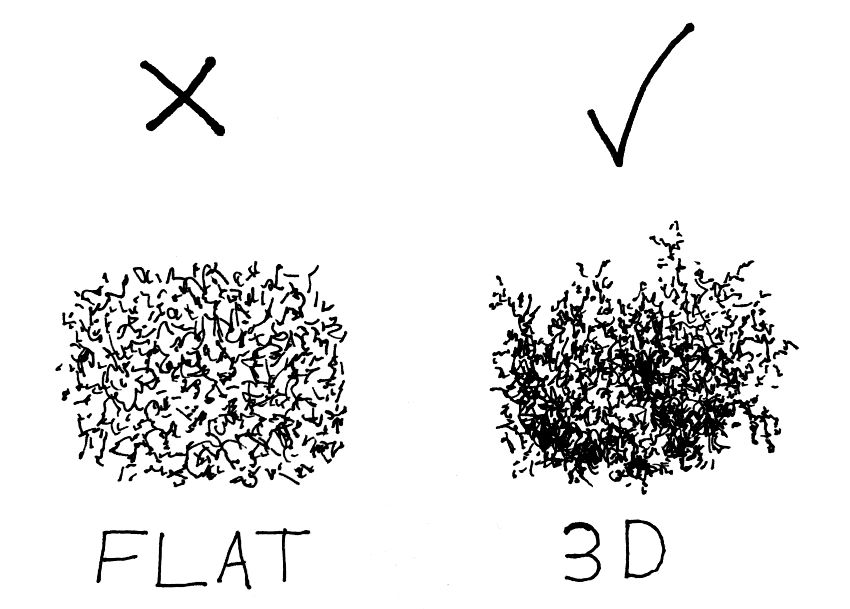
In improver, pay attention to leaves size, depending on the tree type, and how distant it is from the observer.
For big leaves, sketch large marks, and vice versa:

While the treetop is messy, at its edges you lot can add some indication of leaves blazon and size.
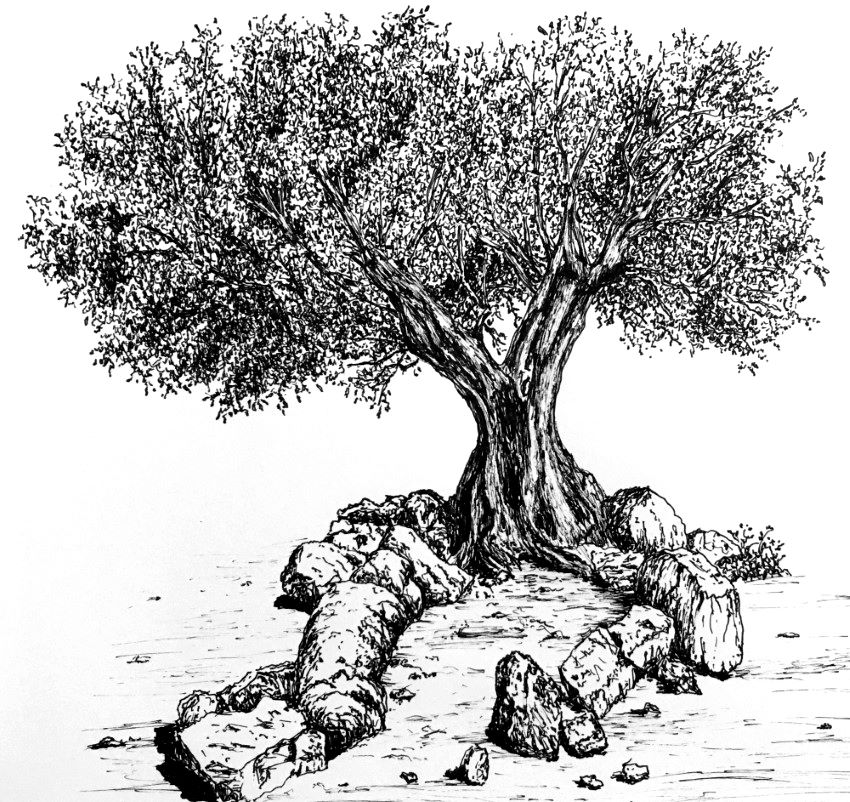 Olive tree
Olive tree
After understanding the characteristics of a specific tree (olive tree in this instance), it is quite easy to describe it from imagination.
If some terms like foreshortening and overlapping are new to you, read my guide on how to draw with a sense of depth. Information technology covers 15 methods to add depth to your drawing or painting.
Good to know:
Mostly, I utilise a pen with nib size 0.ane. It is small plenty to create fine details.
Photos & Contrast
When I am taking photos of a tree, I practice information technology from several angles.
If possible, I circle the tree to go a photograph from every bending.

I select a photo that has high dissimilarity equally my reference paradigm.
Dissimilarity betwixt highlights and shadows is crucial for a cartoon to stand up out, and to take presence.
Not plenty contrast leads to a flat drawing with no depth. Too much contrast looks cartoonish.
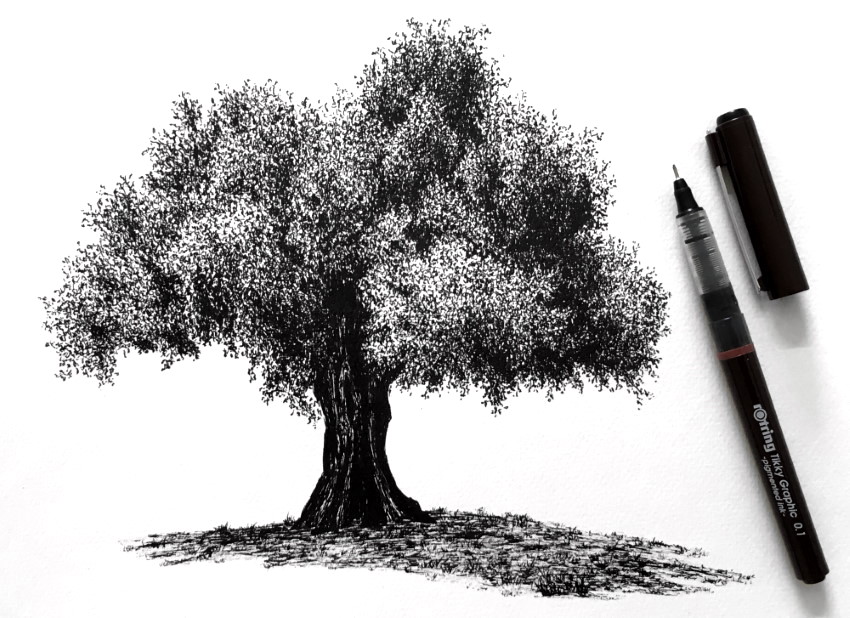 Olive tree
Olive tree
Pine Trees
Of import:
Before diving into circuitous texturing and rendering, if you lot are a beginner, you might want to practise the next step.
Draw whatsoever random tree shape, sketch some random marks to fill it up, so draw more sketchy marks in one side and at the bottom of the tree (to create a darker value for the shadow area).
This should not take more than than five minutes! The advanced texture you volition run into afterward this instance is simply a matter of many hours of practice to refine the texture marks.
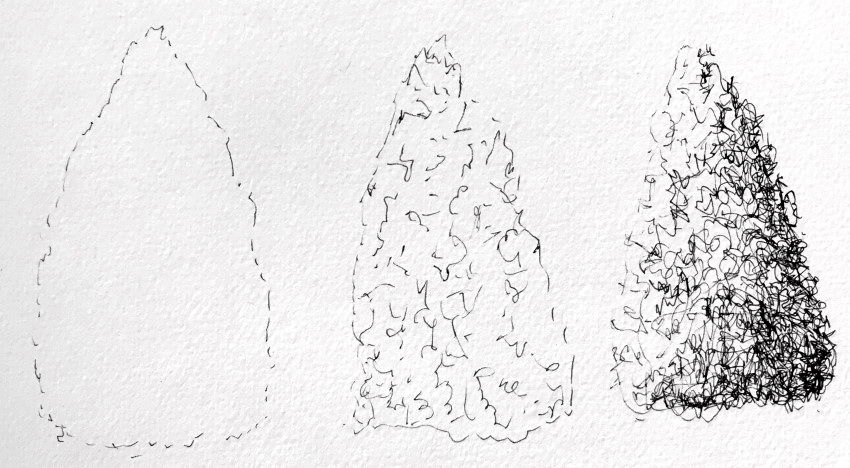
Pine trees are relatively piece of cake to draw from imagination.
They have very small-scale, needle-like leaves.
I like to start by gently drawing the course, then fill up it with pocket-size, random marks, that are NOT in any specific direction or with reoccurring shape.
Last footstep is to depict more marks for darker areas, depending on the management of calorie-free you choose.
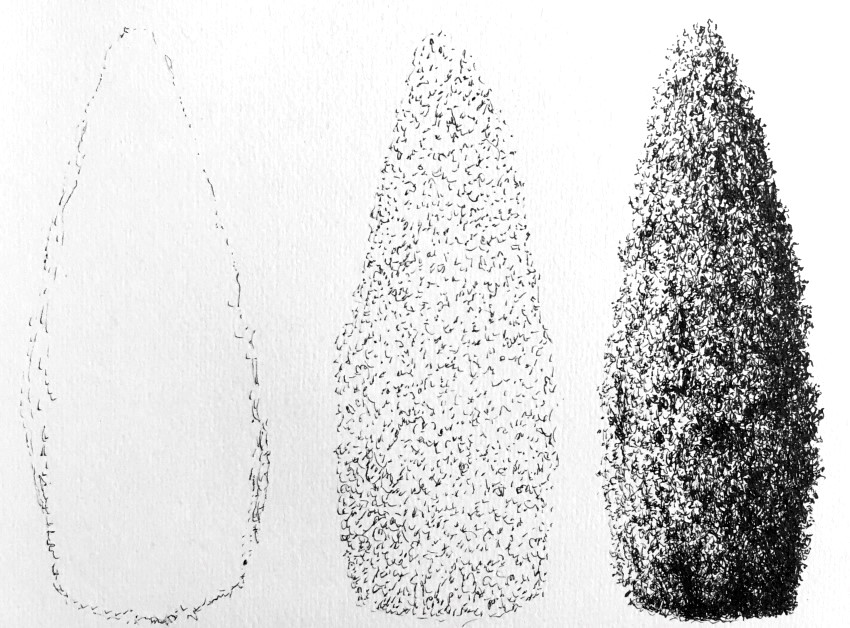
Pine trees come in many types and shapes.
Looking at a reference image tin help at the beginning, only as a guide to depict the form, and to pay attention to dark and light areas.
Other than that, endeavour to exist loose and sketchy with your marks.
When drawing a close-up view, you tin can betoken the needle-like leaves at the edges of the tree.
 Pine tree
Pine tree
Snowy Pine Tree
A pen has only one effulgence value. Therefore, you have to employ dissimilar techniques to create the illusion of transitions in brightness values.
One technique (or style) is to utilise hatching. Hatching ways drawing parallel lines.
By drawing lines with different degree of spacing between them (or with different line width), you tin can create an illusion of different effulgence values.
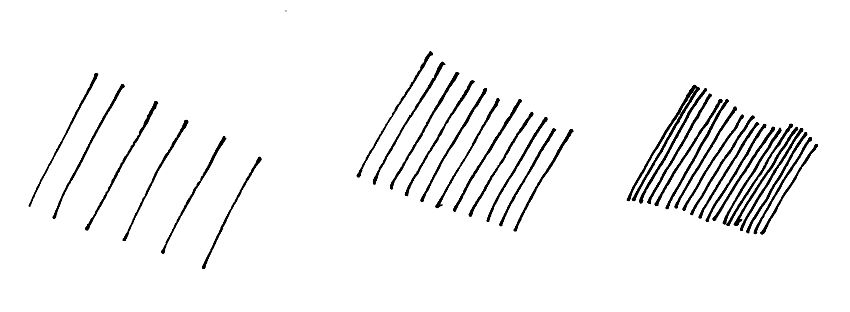
Some other method is to employ cross-hatching.
Cross-hatching means cartoon sets of parallel lines in unlike direction. By calculation more sets of cross-hatching, you can create the illusion of darker values.

You can utilize ANY pen for drawing. I prefer artist-form technical pens (also fineliners). They create lines with stock-still width, and their ink is fabricated of pigments, which is very durable and lightfast.

For the snowfall part, yous can leave it empty ("white"), or yous can utilise hatching in some areas.
In this example, I used some hatching, and some marks with very calorie-free greyness marking.
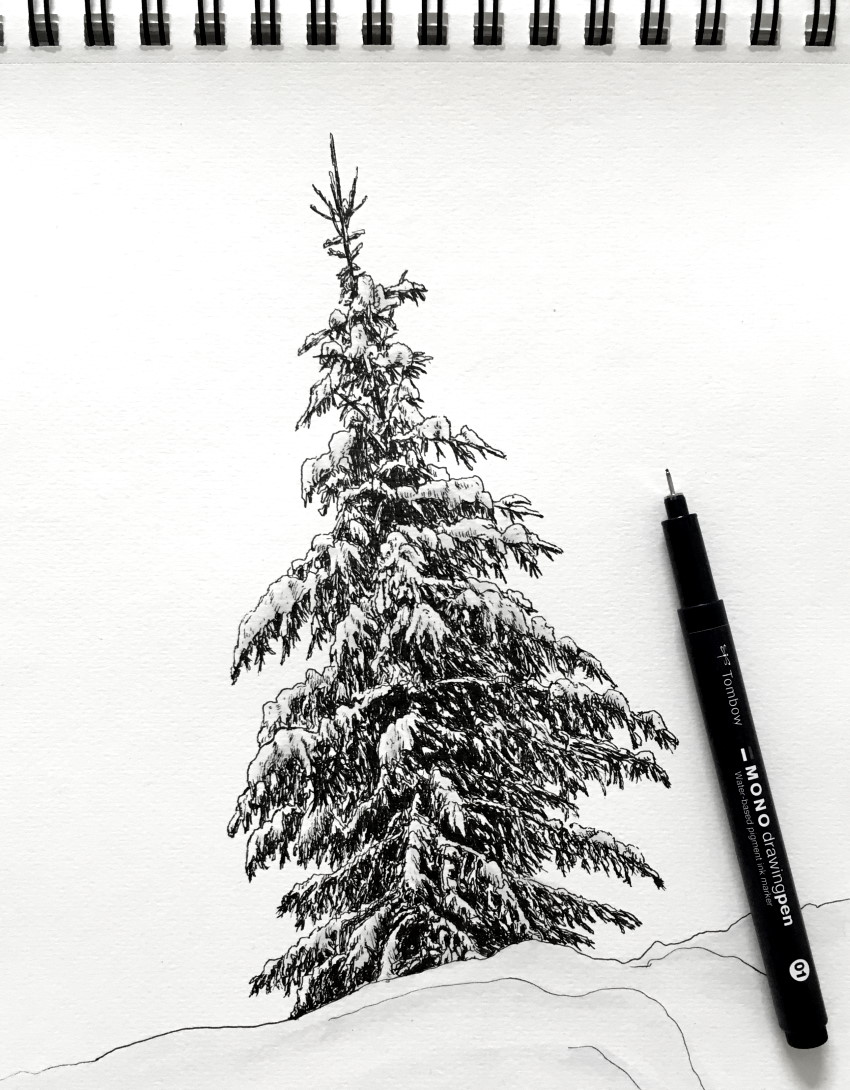 Snowy Pino tree
Snowy Pino tree
If you want to know more near markers, visit my markers review for artists.
Christmas Tree
A Christmas tree is just another pine tree, but with decorations.
To add together some baubles, beginning describe their shape, and so try different types of hatching, cantankerous-hatching, and stippling.
Stippling is a cartoon technique that uses dots. The more dots you lot add in one expanse, the darker it looks.

You lot can add together other decorations to your Christmas tree.
It is all-time to first sketch some test drawings on a different paper, to see what works, before adding them to your drawing.
To add boxes in perspective, you should be familiar with linear perspective drawing, and larn to draw from imagination.

Tip:
If you find it hard to draw a tree with a pen, yous can e'er starting time with a pencil.
When y'all reach a satisfying effect, you can go over information technology with a pen, and gently erase the pencil marks.
 Christmas tree
Christmas tree
Drawing with White Pens
When drawing with white pens, pay attention to the same drawing fundamentals.
While with black pens you draw more lines for darker areas, with white pens you lot should draw more lines for light/vivid areas.

These pens are most effective on black (or dark) paper, and for highlights.
Keep in heed:
White pens are designed for covering.
Cartoon with a black pen (which has ink) over white areas (made by a white pen), may ruin the pen's pecker, because information technology volition be covered with the white substance (therefore its ink volition not flow smoothly).
Aspen & Birch Copse
Aspen & birch tree trunks are like shooting fish in a barrel to draw when doing it in steps.
Draw the form first:
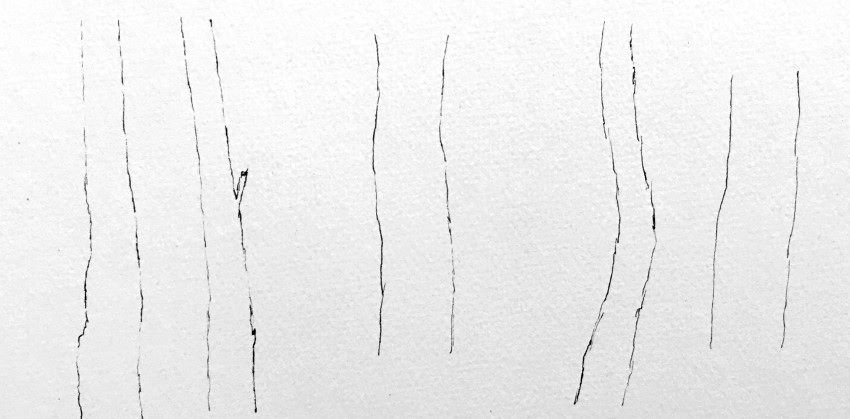
Then, add some basic details:
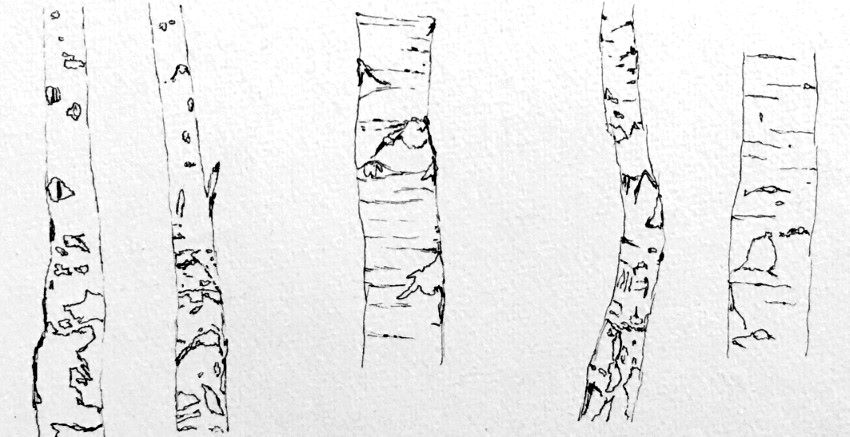
Finally, draw some brightness values, and texture:
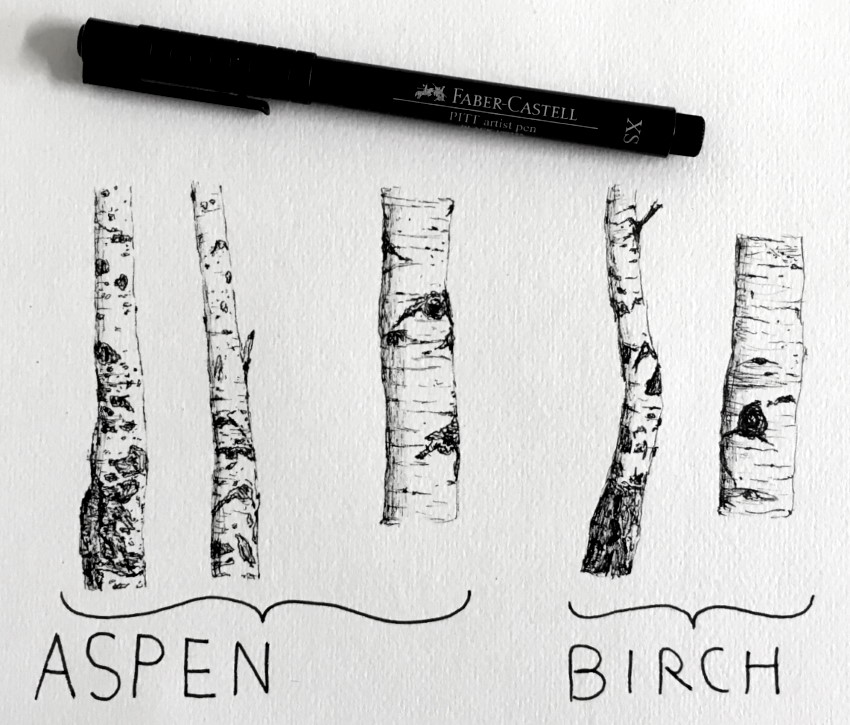 Birch & aspen tree trunks
Birch & aspen tree trunks
You tin employ (light) gray markers for coloring:
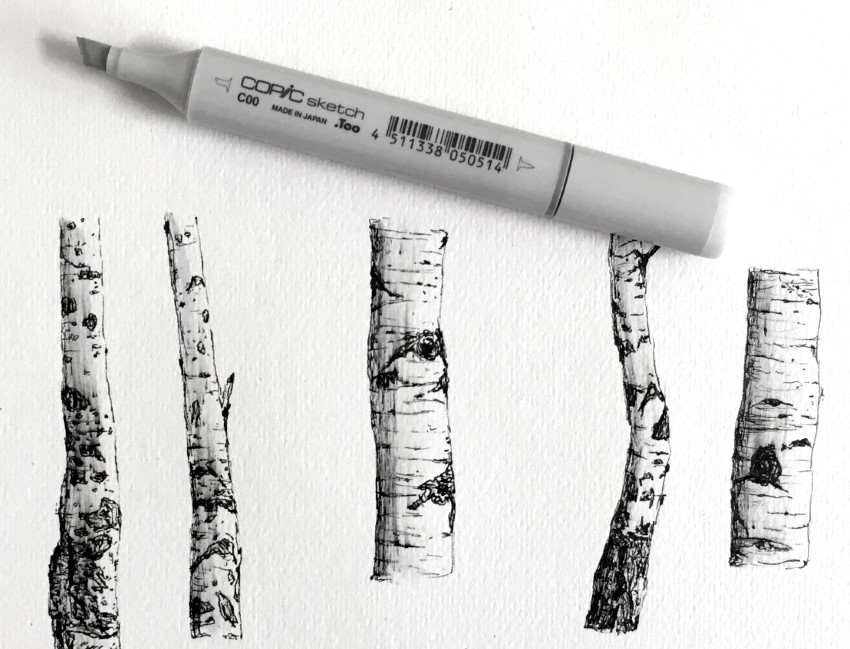
Overlapping
Overlapping means an object that partially covers another object.
When y'all run across an object that overlaps some other object, you assume that this object is in front end of the object information technology covers.
Overlapping is 1 of the most powerful ways to create the illusion of depth on a flat paper.
 Overlapping trees
Overlapping trees
Considering y'all cannot erase pen marks, information technology is best to draw foreground objects first!
If yous want to depict a house in front end of a tree, draw the house get-go:
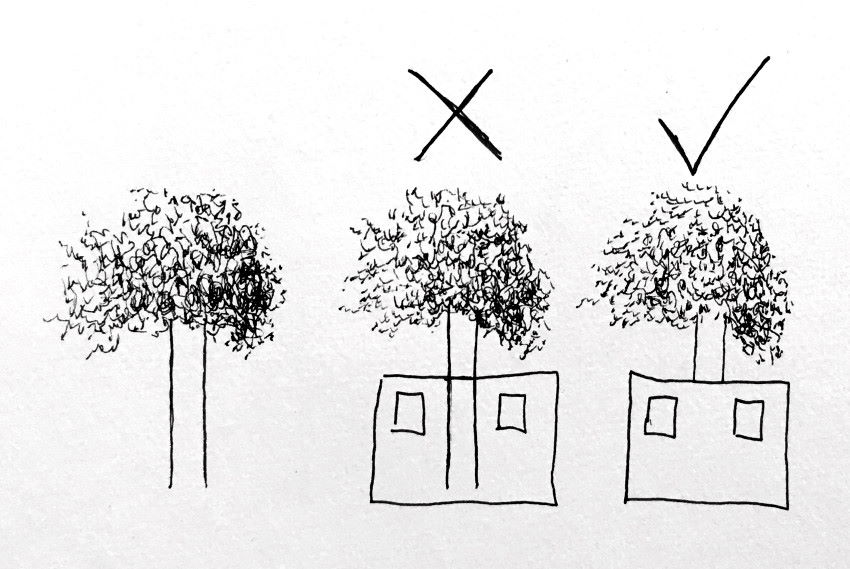
Do the same for tree branches.
Starting time, describe the branch that overlaps a tree, so the tree trunk.
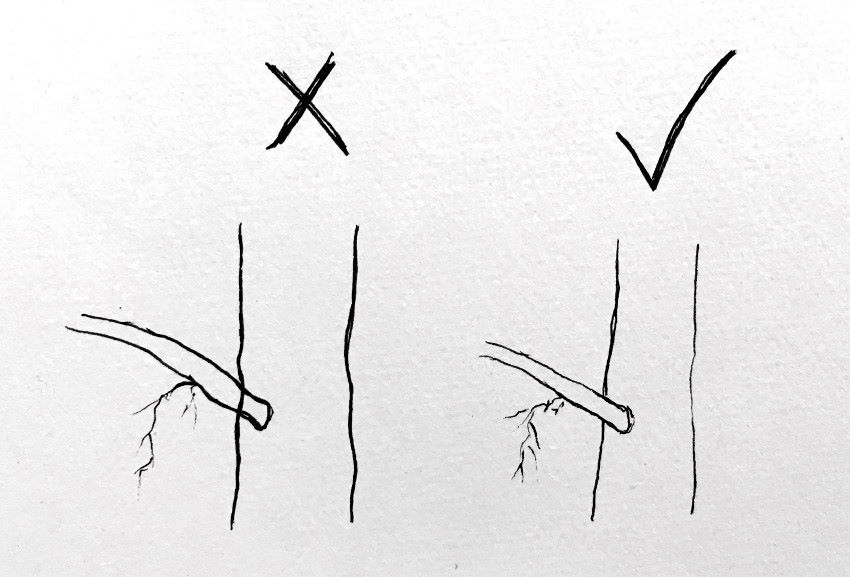
For copse that have a complex construction, with many branches, you can use a pencil to draw the bones shapes.
When you are happy with the result, you can draw over it with a pen, and gently erase the pencil marks.
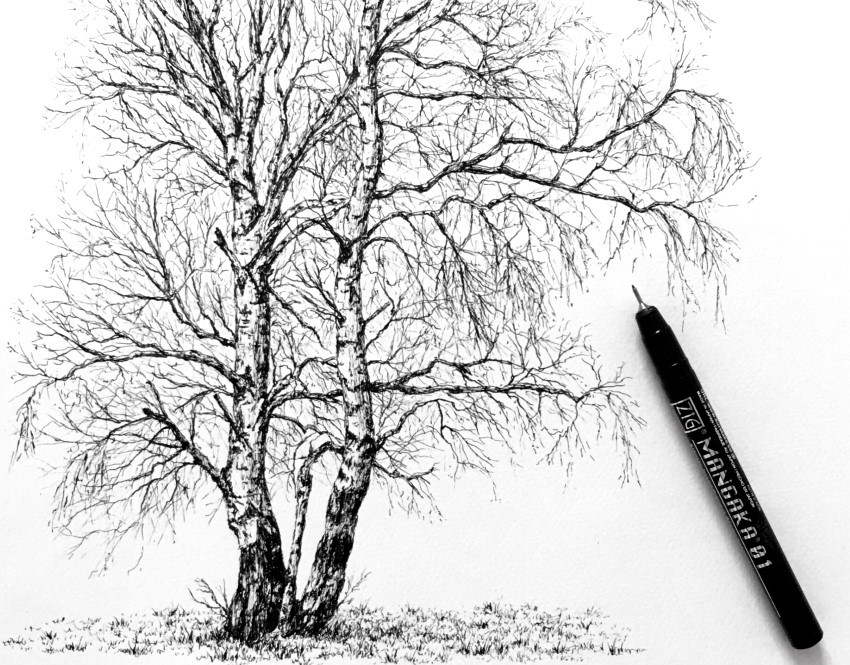 Birch trees
Birch trees
Transitions
Transitions are part of cartoon (and painting) fundamentals. They exist everywhere!
For example, different areas of a flat plane have different relationships with any calorie-free source, reflections, and shadows.
Therefore, always look for transitions (in effulgence values) for your drawing to wait realistic and natural.
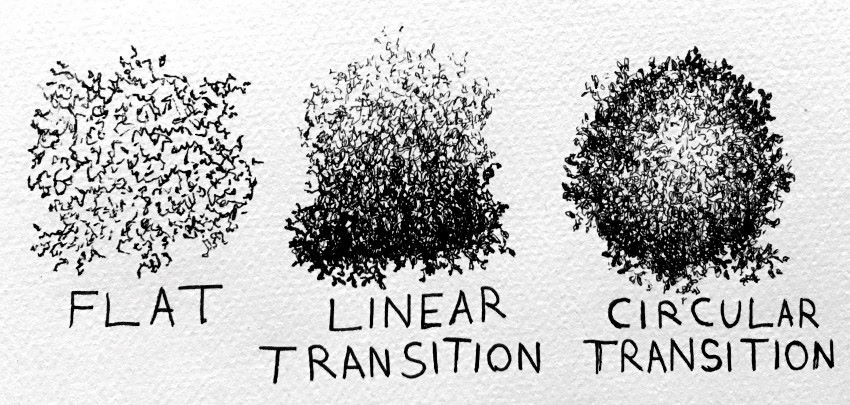
First, look for light and dark areas.
Then, look for transitions within each surface area. Transitions from dark to light, from lite to lighter, and from dark to darker.
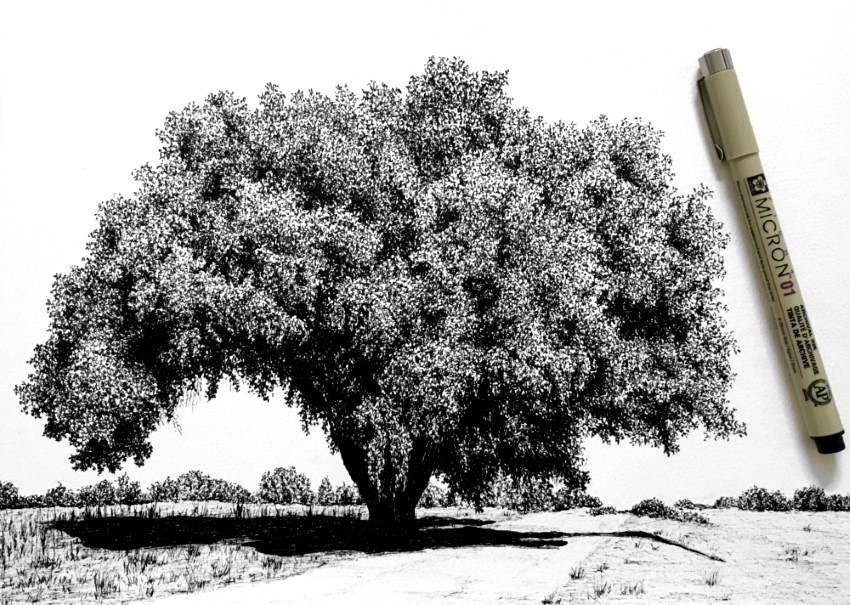 Oak tree
Oak tree
By cartoon with NO transitions (and using difficult edges), y'all tin can create something that looks unnatural, as opposed to something realistic with transitions.

The same fashion a gardener trims bushes and trees, yous can apply your creative license to create something that looks artificial or man-made:
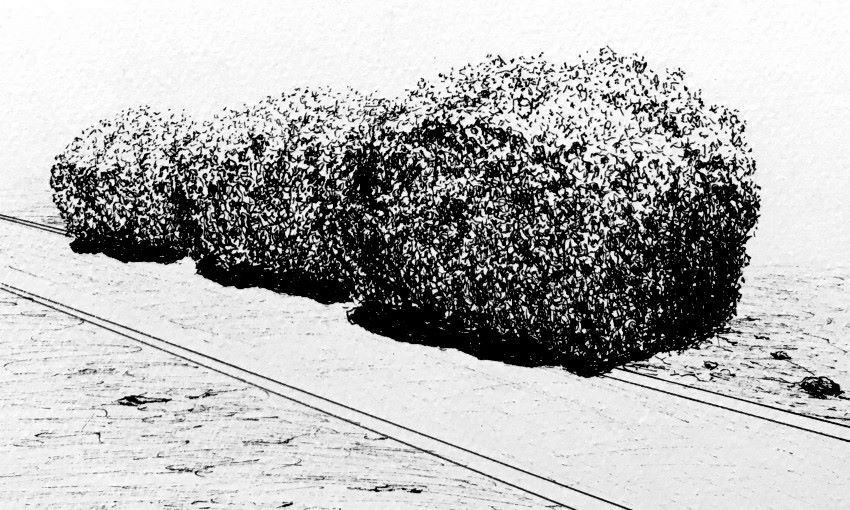
Artistic license means to utilise your knowledge and experience.
Once yous sympathize how to draw leaves, you can draw annihilation with leaves texture. Objects, figures, vehicles, or even a refrigerator:
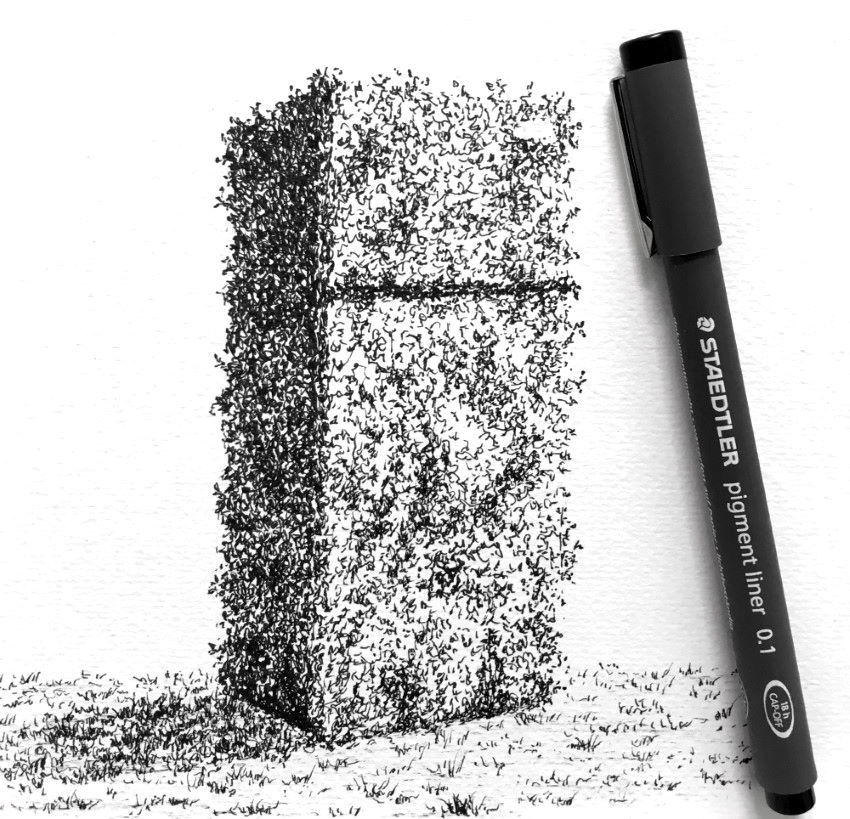
Practiced to know:
Transitions are not limited to brightness values. Transitions exist in colors, texture, edges, and temperature (transition from warm colors to cool colors).
If you are struggling with realistic cartoon, y'all might want to read my realistic pencil-drawing guide. It covers the iv of import fundamentals (accuracy of the course, brightness values, edges, and transitions).
Weeping Willow
A weeping willow tree is a fleck tricky to describe.
Its leaves are easy to draw at an up-close wait. Equally you get farther abroad, yous can come across long clusters of leaves with no unmarried leaf shape.
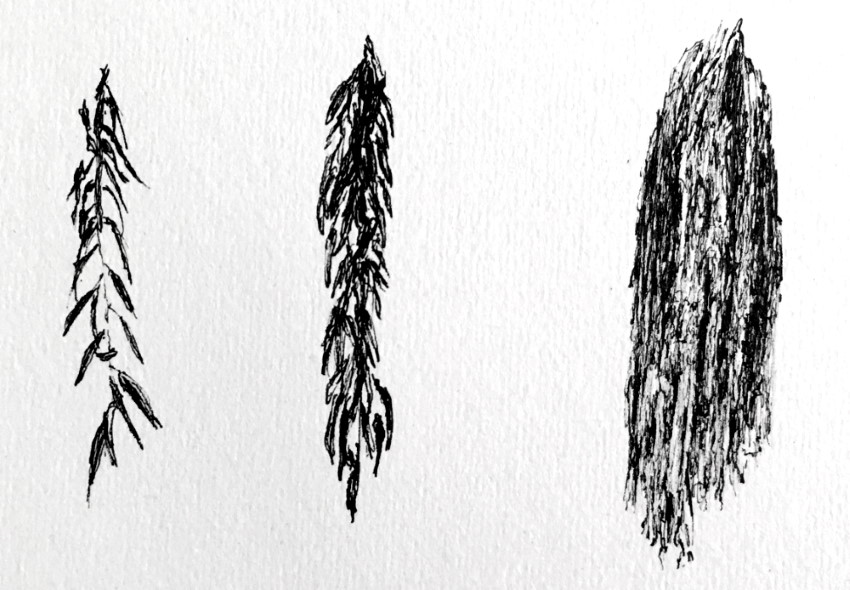
You tin start by drawing an outline for the tree structure. Practice it gently.
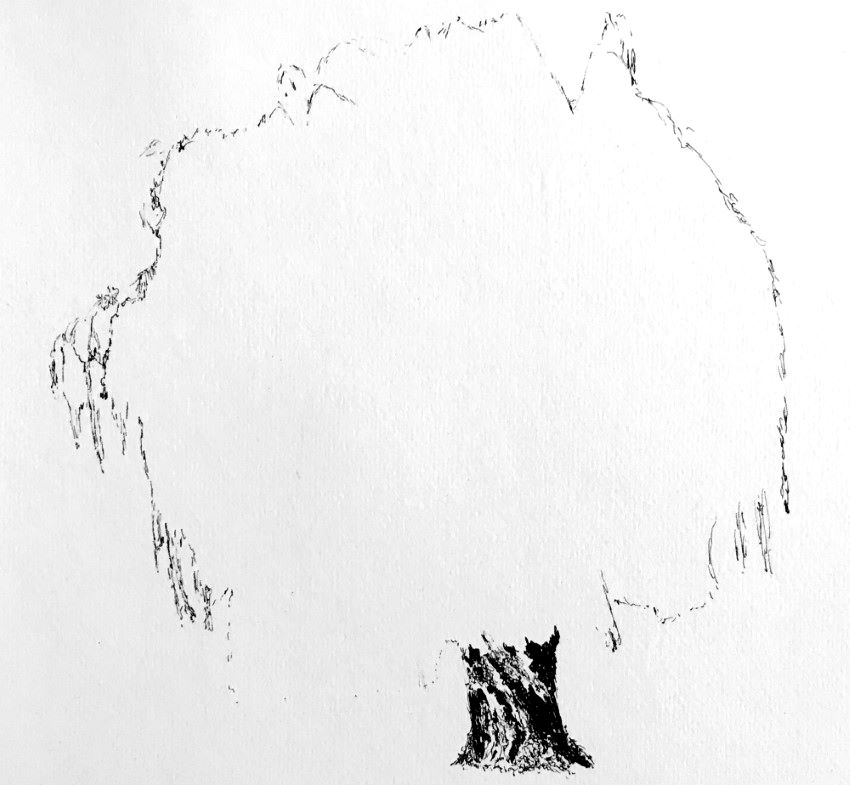
Then, i fashion is to describe the treetop (crown), section by section.
Alternatively, like in this example, you lot tin can draw the dark values kickoff.
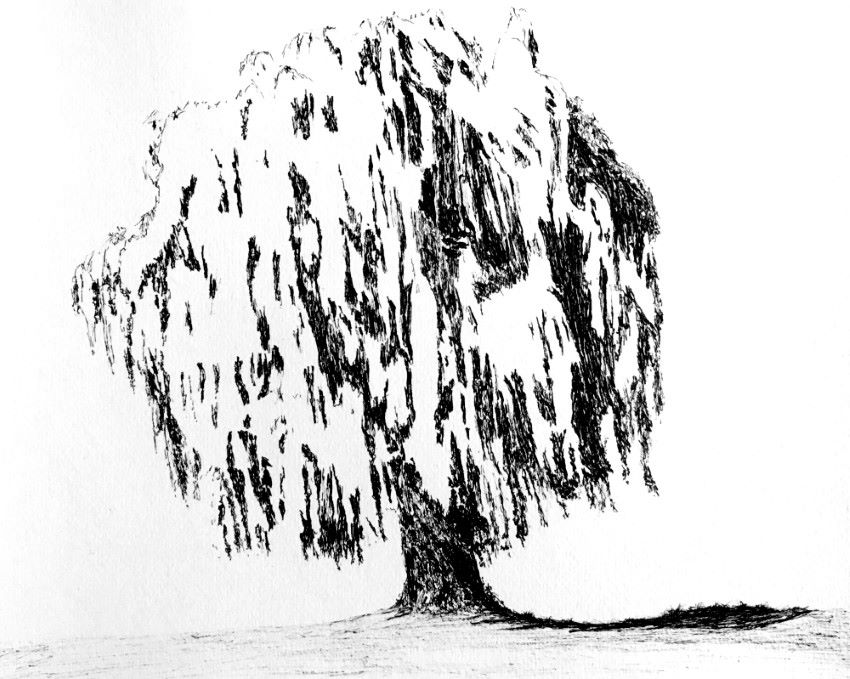
Something to consider:
As mentioned to a higher place, a pen has one brightness value (normally black, though other colors exist, more on that later).
Past cartoon gently and swiftly, with a sharp angle, you can produce lines that are less defined, and therefore with a lighter value.
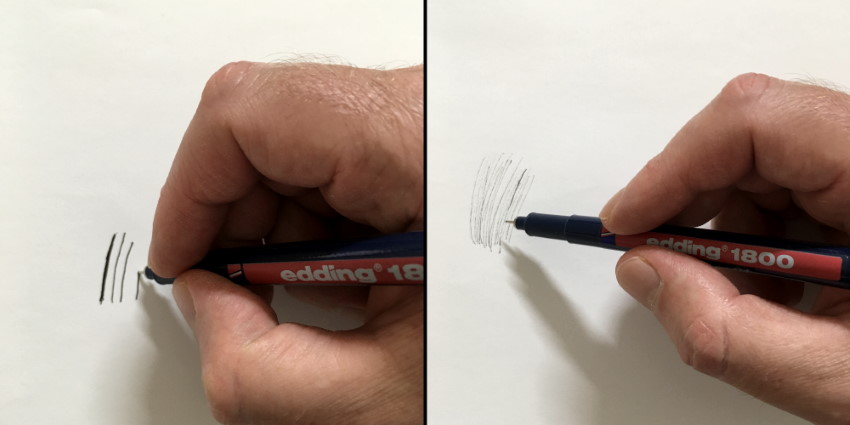
The last step is to add the light values.
Pay attending to brightness values, transitions, and texture. Be abstract with your marks, yet with a sense of direction.
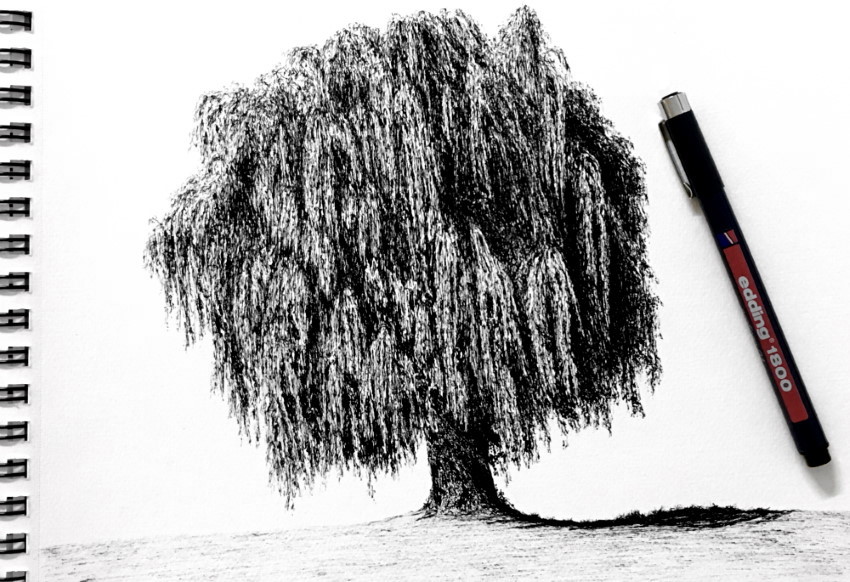 Weeping Willow
Weeping Willow
How to Draw Huge Trees
For some big trees, like Ficus, I like to use a big paper sheet (A3 in this instance).
If the tree is too complex to draw, yous tin describe a grid (softly with a pencil), to split up the paper into smaller sections (and use the same grid for your reference epitome).
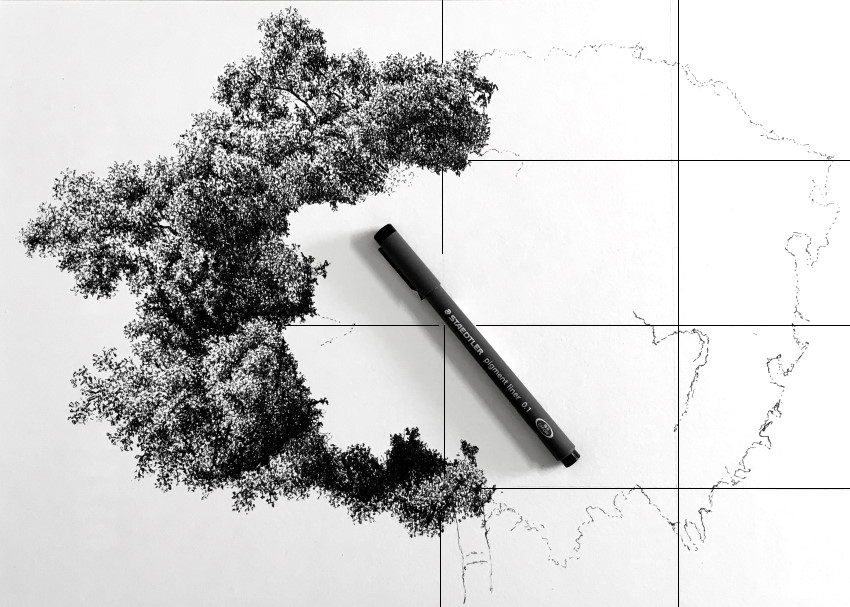
Go on in mind:
Drawing on a big paper with a pen (or a pencil) is time-consuming. For a tree like this, it can easily take more 20 hours to complete.
 Ficus tree
Ficus tree
Sometimes, huge drawings may not look so big on a small screen.
Y'all tin can requite it context by adding background trees (from imagination in this case).
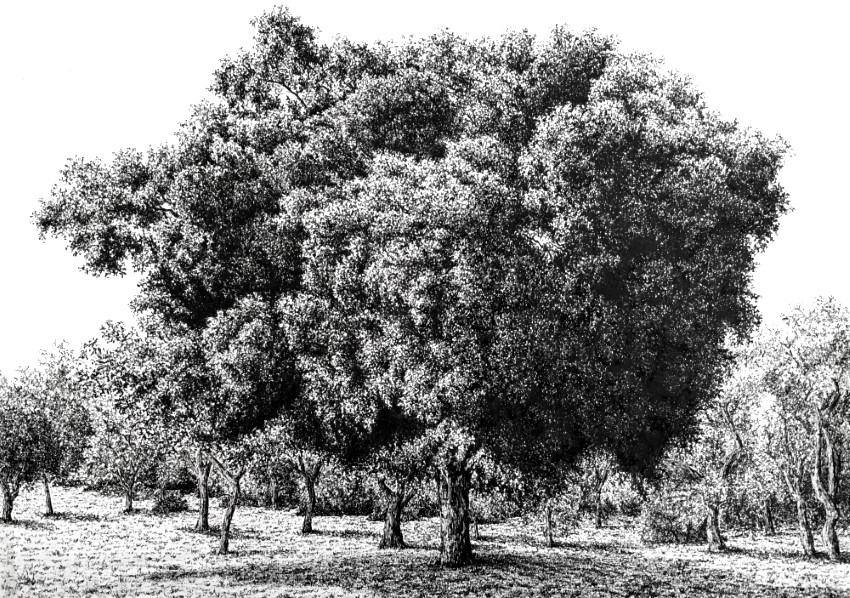 Background cartoon
Background cartoon
Something to consider:
You should utilize the rules of atmospheric perspective when cartoon backgrounds (mural).
When objects are far away, there are more atmosphere particles (that scatter low-cal) between them and the observer.
For far away objects, use less contrast and fewer details. In addition, groundwork layers become lighter, and have soft edges.
Adding Background
Trees are beautiful on their own. Sometimes though, yous may want to add together a background.
Drawing grass is a uncomplicated and piece of cake solution for background.
Start by drawing some short lines. The lines in the front should be a bit bolder and longer.

Add more lines; some tin be longer (mostly in the foreground).
Avert any design, and try to be abstract with your marks.

With a tree (eucalyptus in this case), grass (as background) adds depth.
At that place is no actual depth in a drawing, your newspaper sheet is apartment. The higher you draw on your paper (until the horizon), the farther away it looks.
By drawing cast shadow by the tree, y'all can add a sense of space to your drawing.
To draw cast shadow, add together more marks (lines) for that area, to create the illusion of night value.
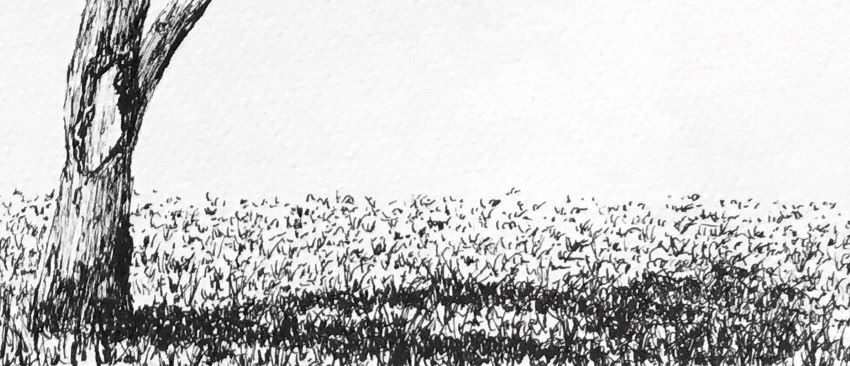
Adding Plants
Another option is to add together some plants. For case, cattail plant (Typha).
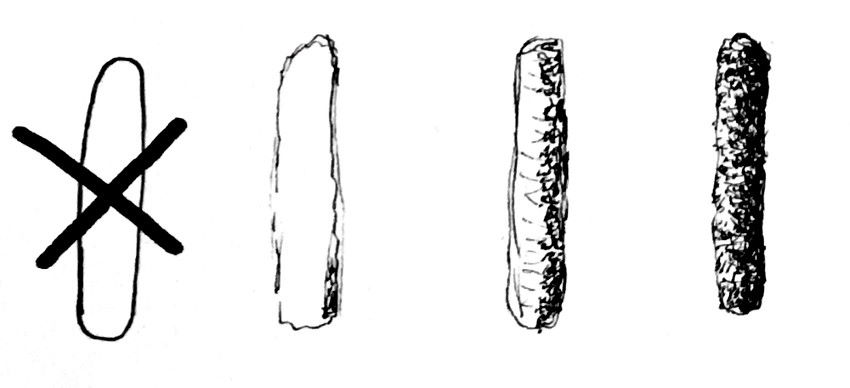
Remember:
Natural plants and trees have an abstract shape. Make sure y'all practice not draw them too round and uniform.
When drawing long leaves, pay attention to cast shadows:

Subsequently examination-drawing the plant's parts, depict some loose outlines.
For realistic results, draw each flower or leaf with different size, shape, and direction (but, keep in heed the tree or institute characteristics).
Additionally, pay attention to overlapping.
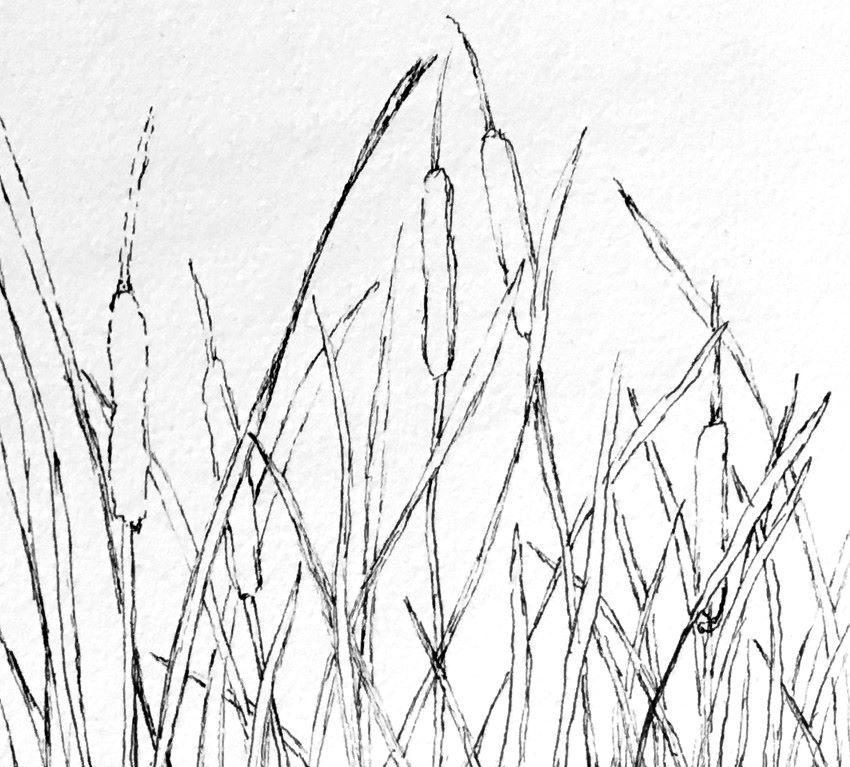
So, add some brightness values and cast shadows.
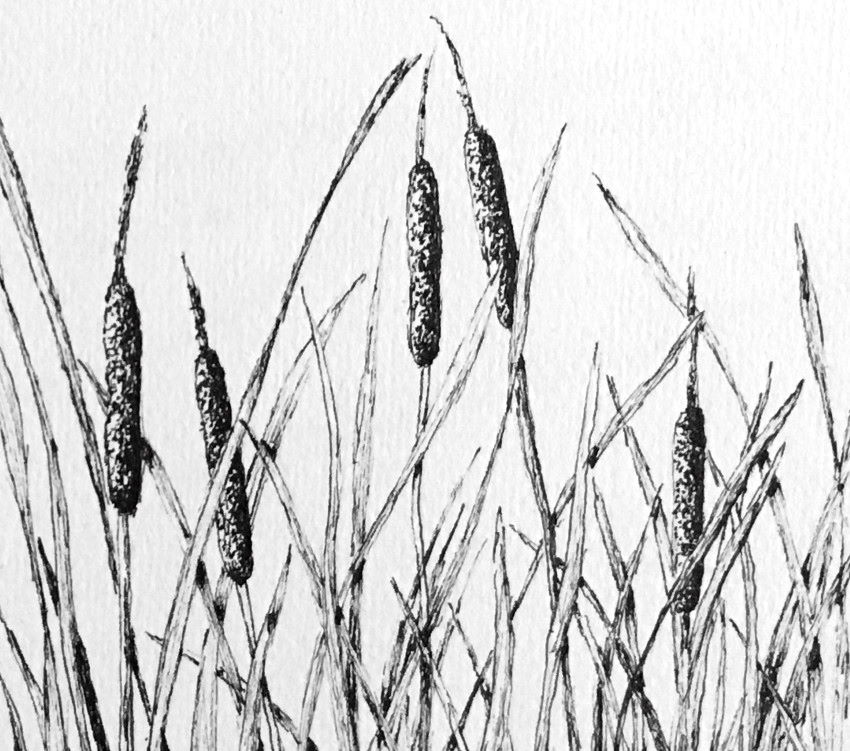 Cattail
Cattail
Now you can combine grass and plants to draw a landscape.
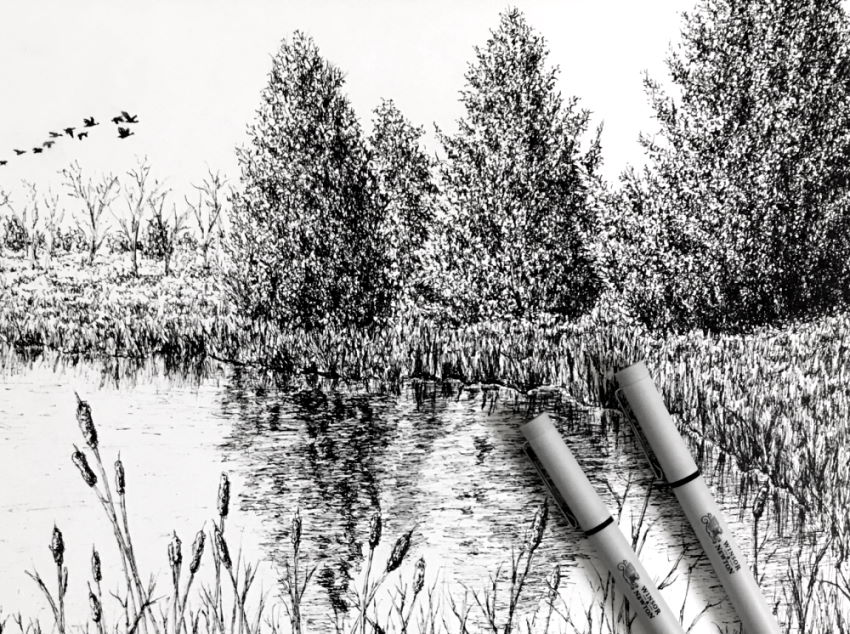 Landscape pen drawing
Landscape pen drawing
And, paint it with markers.
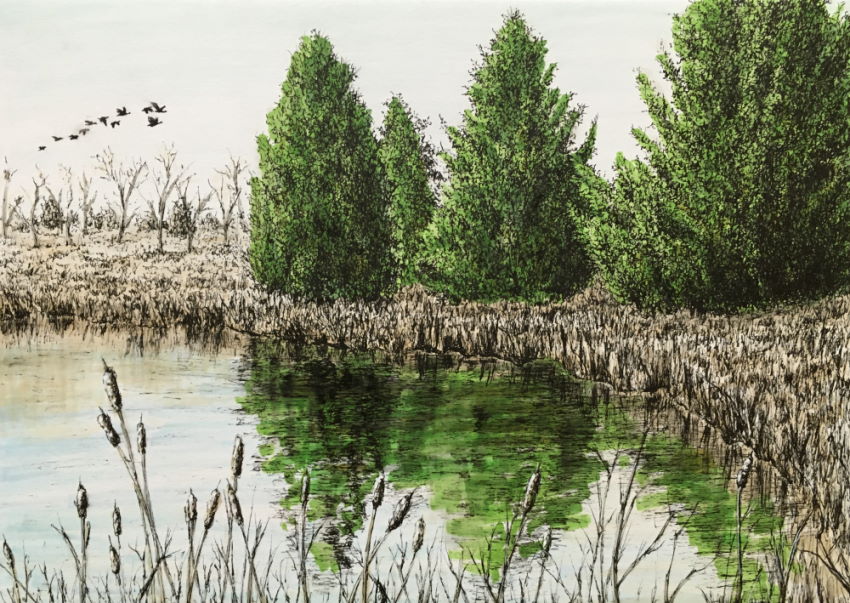 Coloring with markers
Coloring with markers
Size & Context
The mode to ascertain the size of objects is by placing them well-nigh other familiar objects.
Although a worm is usually quite small, by cartoon it large compared to known objects like copse, it is possible to create a behemothic monstrous worm.
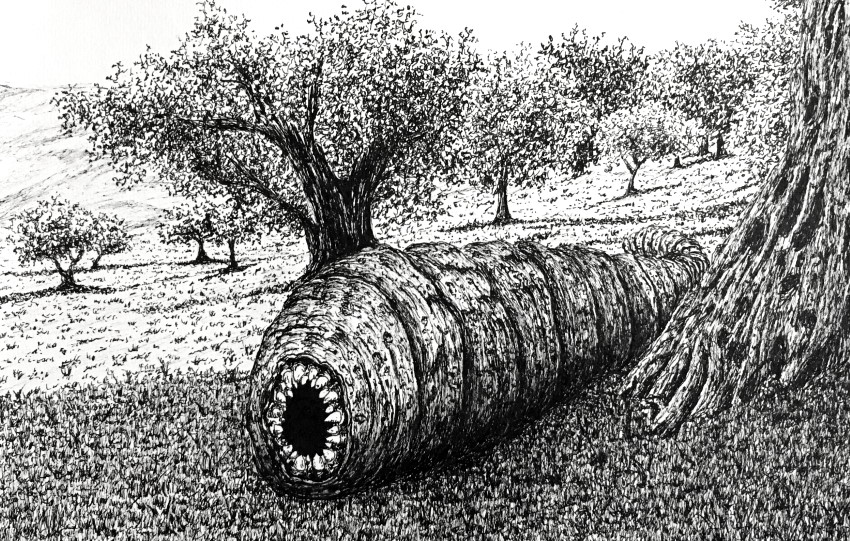 Giant worm
Giant worm
On the other manus, you might want to draw a small tree, like a bonsai tree.
In this case, you lot need context.
Cartoon a tree in a plant pot tin can help, just sometimes even big trees are sold within pots.
Drawing familiar surroundings, like a room, can help a lot in defining the bonsai'southward size.
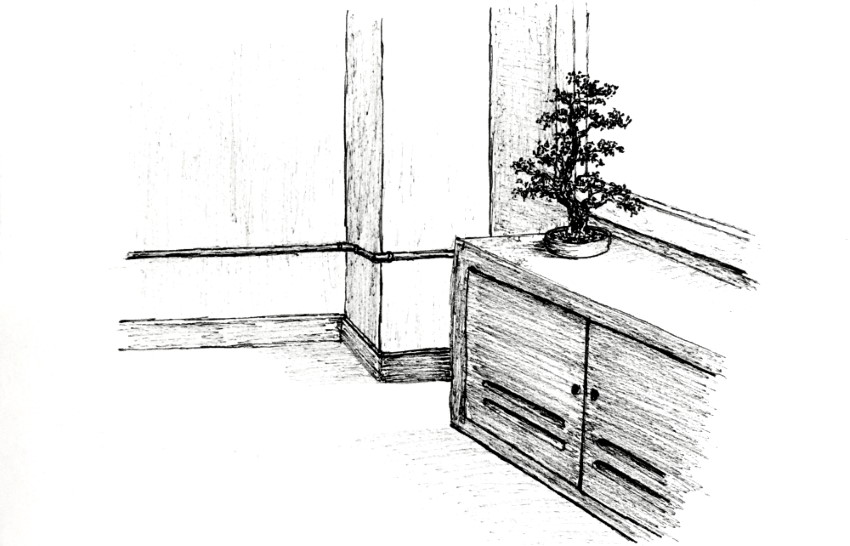 Bonsai tree
Bonsai tree
Colored Pens
While the main color for technical pens is black, many brands offer other color options.
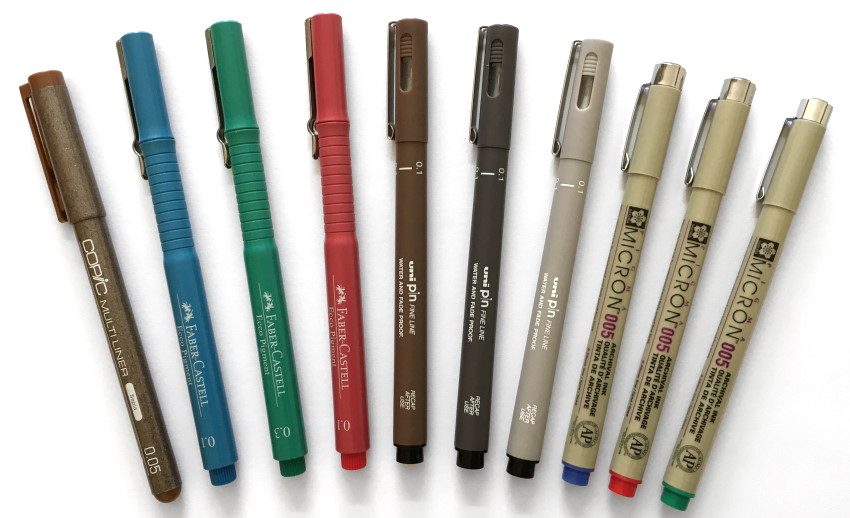 Colored technical pens
Colored technical pens
I prefer black ink, merely occasionally I like to mix it upwardly with colors.
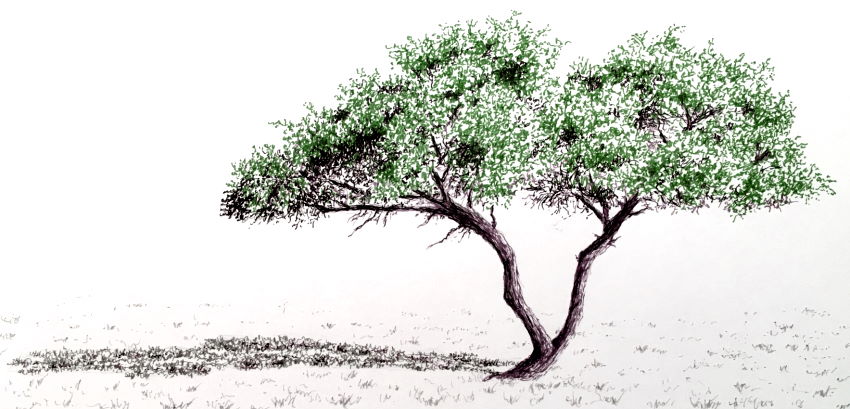 Acacia tree
Acacia tree
Log
To describe logs, timber, or tree trunks, starting time by drawing the outlines gently.
Pay attending to foreshortening, and add some bones details.
Lastly, make up one's mind where to place the lite source, and draw a gradual transition in effulgence values with sketchy marks.
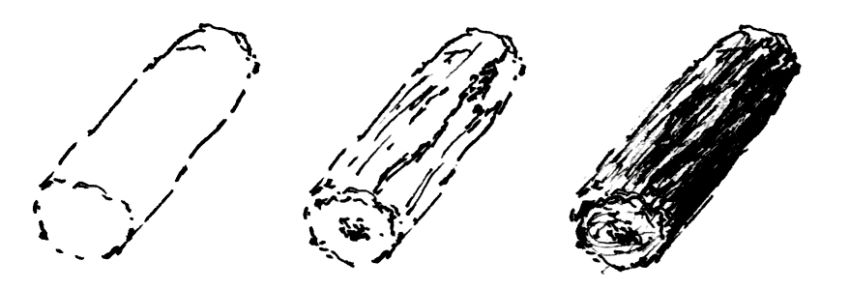
Transitions:
A cylindrical object has a transition in brightness values, from dark to light.
When using a black pen, draw more lines for darker areas.
Some other option is to depict less defined lines (swiftly at an bending), and add more lines for darker values.

Colored pens:
Different black pens, colored pens come in unlike levels of opacity.
When cartoon more in the aforementioned surface area, the pen creates a darkness value. Sometimes you can let the pen ink dry, and then describe over information technology again.

Edges:
Cast shadows commonly have soft edges (see below how the cast shadow from the rope has a soft edge).
When you scribble the forest texture, you desire to have some dents and holes in some areas.
Draw these dents with a hard edge on their darker office, and a soft edge when the transition ends (the light side of the paring, or hole).
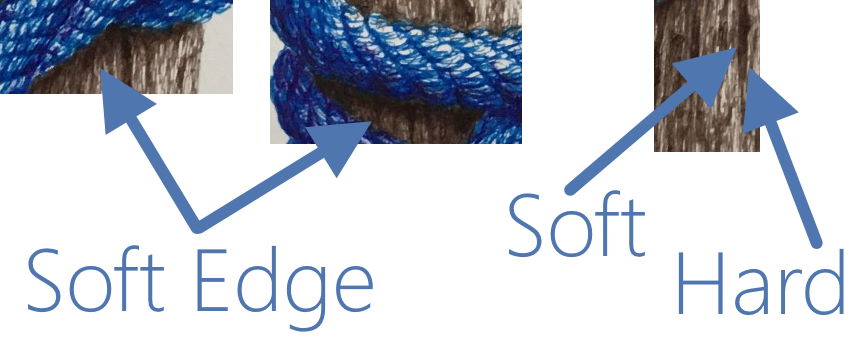
For a more than realistic rendering, with more details, draw large.
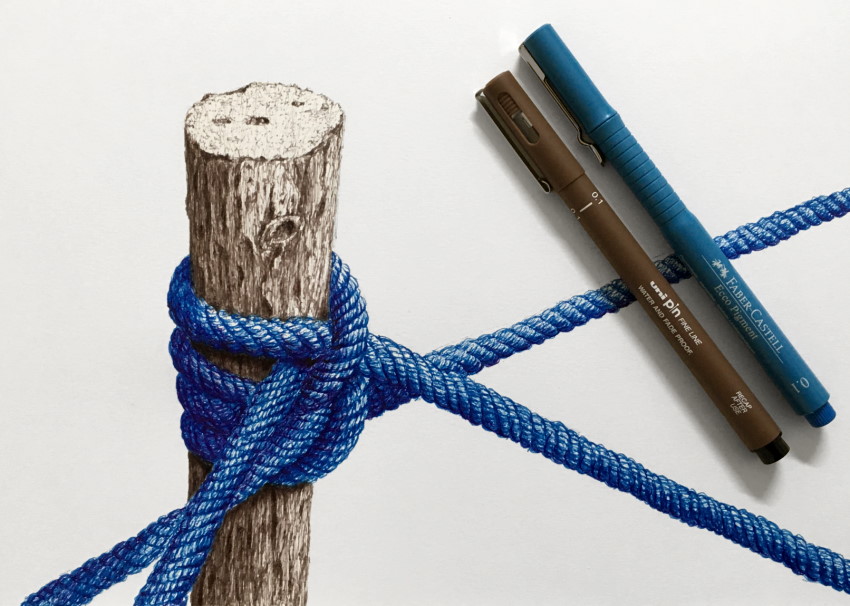
Summary
While there are no lines in nature, pens tin only create lines!
Drawing is creating an illusion. The world is iii-dimensional, but your newspaper-sheet is two-dimensional.
To create this illusion, pay attention to brightness values, edges, and transitions (among other things).
A pen has only one brightness value, so, unlike other cartoon mediums (graphite, charcoal, pastel...), you have to create the illusion of different brightness values and transitions (in brightness values).
When drawing copse, focus on accuracy of the form, and on brightness values.
Brand sure you have enough contrast between highlights and shadows, for the drawing to be noticeable.
After you master drawing the form and brightness values, details (texture) make all the difference.
If you liked this article, yous might similar my flower pen-cartoon guide too.
For my recommended pens that I used in this guide, visit my review for fineliners and technical pens for cartoon.
![]()
![]()
Copyright © RanArtBlog.com. All Rights Reserved. | Sitemap
Source: https://ranartblog.com/blogarticle10.html
Posted by: juarezazzent.blogspot.com


0 Response to "How To Draw Snow Covered Pine Trees"
Post a Comment